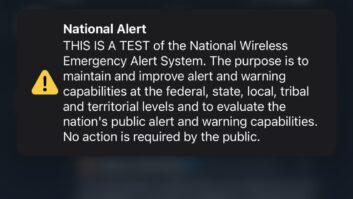The results are in. Just how successful was the most recent national EAS test?
The latest nationwide test of the Emergency Alert System, held on Sept. 27 at 2:20 pm Eastern, was designed to assess the reliability and effectiveness of the nation’s EAS system, with an emphasis on how well common alerting protocol-based (CAP-based) EAS alerts were disseminated to EAS participants through the IPAWS gateway (otherwise known as the Integrated Public Alert Warning System, which is coordinated by the Federal Emergency Management Agency.
The test also provided offered an opportunity to see what lessons had been taken to heart from the 2016 nationwide EAS test.
The initial test data reveals that the majority of EAS participants successfully received and retransmitted the National Period Test code used for the test, the FCC said. Overall, the FCC said, performance appears to have improved over the 2016 nationwide EAS test.
In all, 19,069 participants submitted EAS test information into the commission’s EAS Test Reporting System (ETRS), which is 1,320 fewer than submitted data in 2016 (which was a total of 20,389.)
When it came to receiving the test, 95.8% of test participants successfully received the test alert, a minor increase from the 95.4% success rate in 2016. Retransmission went well too: This year, 91.9% of test participants successfully retransmitted the test alert, up from the 85.8% who successfully retransmitted in 2016.
When it came to complications, 89% of test participants that filed Form Three reported no complications in receiving the test alert, up from 81.5% in 2016. Likewise, when it came to complications in retransmitting the test alert, 88.3% of participants that filed Form Three reported no complications, up from 80.2% in 2016.
When it came to retransmitting in Spanish, 207 test participants reported to have retransmitted the IPAWS-generated Spanish-language version of the alert, which is a significant jump from the 75 that retransmitted in Spanish in 2016.
This year’s test also tracked how many test participants received the alert over the air versus from IPAWS. This year, 40.7% said it came over the air, while 59.3% said it was delivered by IPAWS. Compare that to the 2016 numbers of 56% over the air and 43.5% via IPAWS.
All of the this data was gleaned from information submitted in by participants via Form One (which included basic identifying information), Form Two (which revealed whether or not the test was received and sent) and Form Three (which revealed how the test was received and if there were any complications).
More analysis is to come. The FCC said it is working with FEMA to continue to analyze the results and release more detailed findings. Those looking for further information can contact Maureen McCarthy in the FCC Public Safety and Homeland Security Bureau at (202) 418-0011.










